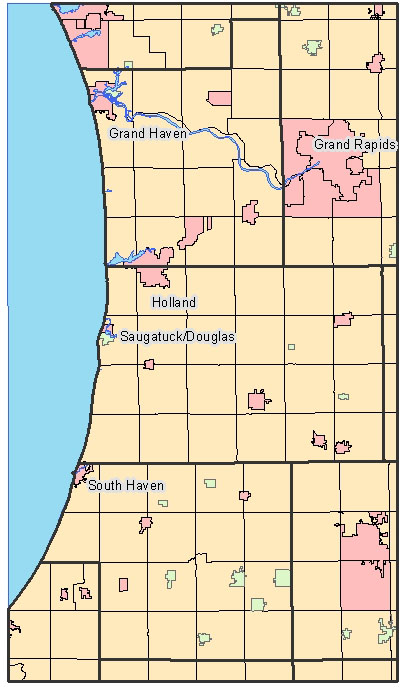
Source: Paul A. Ryckbost, from Michigan Center for Geographic Information data
Paul Ryckbost [mail to ryckbost@umich.edu]
Last Updated: April 19, 2005
Summer is a wonderful time of year in West Michigan, on the shore of Lake Michigan. A time when the sun shines from 6 am until 10 pm. Along Lake Michigan, the temperatures often average a warm, but not too hot, 80 degrees Fahrenheit during the day, and a refreshing 60 at night (Weather.com). The sunshine and the temperatures along the lake, combined with numerous beaches and multiple harbors, make Lake Michigan, and West Michigan in particular, a boater’s paradise each summer.
Source: Paul A. Ryckbost, from Michigan Center for Geographic Information data |
Four communities in Western Michigan take part in this boater’s paradise, each offering different amenities to local and visiting boaters. Four prominent harbors lie along a fifty mile stretch of the coastline of West Michigan: Grand Haven, Holland, Saugatuck/Douglas, and South Haven (See accompanying map). Each harbor has its own uniqueness, each calling boaters for different reasons. The boaters who heed this call inject something special into each community – economic activity. These unique summer tourists help provide for the economic well-being of these communities. In this handbook entry, I will profile each of the four communities, giving a brief introduction to each community’s place in the summer boating industry. I will then summarize and briefly analyze each community’s plans for their waterfront and downtowns. I will end with a look to the future of these communities with respect to boating and economic development. |
The four communities in this report vary in size and stature. The following table identifies each community’s population, the number of boat slips in marinas, and the number of boat slips per person. Note that the boat slips being analyzed are marina slips, not private boat slips – the two types are separated because the purpose of this handbook entry is to analyze the impact of tourist boaters, boaters who call an ports-of-call not their own.
Community |
Zip Code |
2000 Population |
Marina Slips |
Population/Slip |
Grand Haven |
49417 |
27,969 |
1327 |
21 |
|
|
|
|
|
Holland |
49424 |
42,299 |
710 |
60 |
|
49423 |
46,804 |
53 |
883 |
|
49434 |
44 |
225 |
0.2 |
Holland Total |
|
89,147 |
988 |
90 |
|
|
|
|
|
Saugatuck/Douglas |
49453 |
2,517 |
305 |
8 |
|
49406 |
740 |
519 |
1.4 |
S/D Total |
|
3,257 |
824 |
4 |
|
|
|
|
|
South Haven |
49090 |
15,031 |
1022 |
15 |
Sources: Population Data: American Factfinder, http://factfinder.census.gov/home/saff/main.html?_lang=en, April 19, 2005, Slip Data: Recreation Industries Research Center, Michigan State University, http://www.prr.msu.edu/rirc//rmrc.html
The City of Grand Haven sits at the mouth of the Grand River. The Grand River flows from Jackson County in the middle of the state, through Grand Rapids and out into Lake Michigan at Grand Haven’s magnificent light house. The river’s mouth provides ample space and opportunity for boaters to come and go. Boardwalks line the river from Grand Haven State Park to downtown, allowing docked boaters the chance to walk around and see the community. Marinas and public docking facilities line the sea walls, and provide for easy docking for destination boaters. Grand Haven’s downtown is easily accessible to boaters, as Washington Avenue (Main Street) ends at the water’s edge. The city itself is full of beautiful old homes, often with people sitting on their porches on warm summer days and nights.
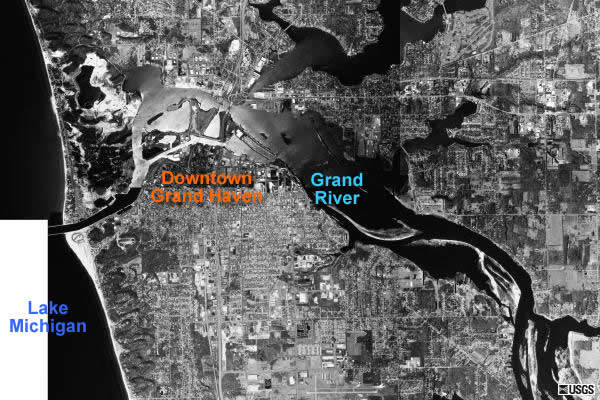
Source: TerraServer-USA - http://terraserver.microsoft.com/
Grand Haven is “Coast Guard City USA,” and its annual Coast Guard Festival is known across the country. Each year, hundreds of boats line up for the Coast Guard fireworks display, which takes place on a hill across the river from downtown Grand Haven. Further upstream on the Grand River is Hanky Panky Cove – a place known for its weekend gatherings of dozens of boats and the activities that go along with the activities one might expect at a cove named Hanky Panky. The Grand Haven area has numerous marina boat slips, along with private slips, that account for much of the local boating activity. Grand Haven is a small town, but on summer nights it is known as one of the “coolest” places to be in West Michigan, packed with people from teens to young families. With all of its different charms and amenities, Grand Haven is said to be one of West Michigan’s best boating stops.
The Holland area is the largest of the four communities. The City of Holland sits along the southern shore and eastern edge of Lake Macatawa (a drowned river at the end of the Black River). Lake Macatawa stretches about five miles from Holland’s downtown to Lake Michigan, where beautiful Big Red lighthouse overlooks Lake Michigan. Boaters have a choice of destinations on Lake Macatawa, from Park Township at the western tip of the lake (Park Township is located on both sides of the lake), to Holland Township on the northern edge, and then the City of Holland at the eastern end. Since Lake Macatawa is ringed by townships, which in general have no specific center, out-of-town boaters really have no other central destination than the City of Holland, except for two large marinas in Park Township (Eldean’s and Anchorage).
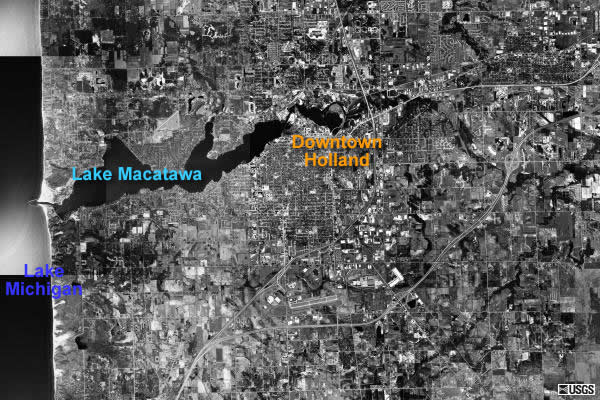
Source: TerraServer-USA - http://terraserver.microsoft.com/
Holland is currently not much of a boating destination. The city has a small amount of public docking, and none allow easy, close access to the downtown area. The public docks are located at two city parks, Van Bragt Park, which is separated from the city by a concrete plant, a coal burning power plant, and a metal scrap yard. The other park, Kollen Park, is separated from downtown by vacant property, a stone receiving yard (ship-to-shore), and the metal scrap yard. Without easy access to downtown, or public docking, destination boaters are mainly limited to Eldean’s Shipyard on the south side of Lake Macatawa in Park Township. Known as one of the best sailing marinas in Michigan, it is often bustling with activity. But that still leaves the Holland area lagging behind the other communities when considering a boating economy.
The Saugatuck/Douglas area, which includes Saugatuck Township and is often known as the Tri-Community area, sits inland from Lake Michigan, connected to the lake by the mouth of the Kalamazoo River. A small lake is situated between Saugatuck and Douglas, along the Kalamazoo, allowing for much boating activity in the area. Saugatuck’s downtown sits at the water’s edge, with numerous streets ending at the water. Various restaurants overlook the public docks at the water’s edge, and a boardwalk circles the entire downtown waterfront. Saugatuck relies heavily on summer tourism, with its quaint shops and galleries, as well as its busy nightspots. Boaters make up a large number of these tourists, since they have easy access to downtown through the local marinas and public dock space. Douglas’s downtown is separate from the water, so it has less to do with boating, but there are a couple large marinas at the city’s shoreline that house a large number of boats. The Saugatuck/Douglas area is well-known in West Michigan as a “place to be.” During the summer its nightlife is eclectic and busy, spurred on by tourists and visitors from Holland and Grand Rapids. On summer weekends, boaters from all over can be seen cruising the Kalamazoo River and docking in Saugatuck to shop and walk around. As the above table shows, indicating four people per marina slip, the area is heavily influenced by boating.
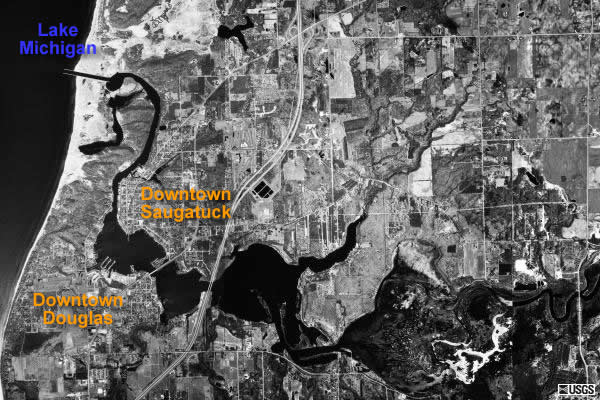
Source: TerraServer-USA - http://terraserver.microsoft.com/
South Haven is a community which I personally know less about than the three previous communities. Located about a half an hour south of Holland, South Haven is quickly becoming known as a new destination for boaters. South Haven is another small town, filled with nice homes and cordial residents. Its downtown is easily accessible to boaters, and is building up with refurbished and new restaurants and gathering places. South Haven is known as an older resort community, with cottages and homes lining the Black River that runs out to Lake Michigan, as well as looking out over the bluffs of Lake Michigan. With ample public docking and other marina space, South Haven looks to be a new hot spot in destination boating.
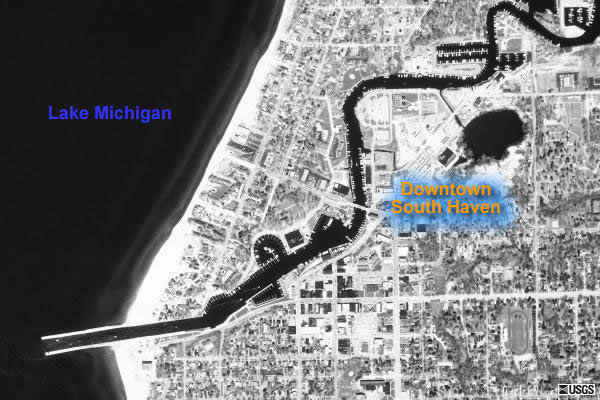
Source: TerraServer-USA - http://terraserver.microsoft.com/
Knowing a little more about each of these communities, it may be asked, how did these cities become such boating (or not become, as in the case of Holland) destinations? Each community has its own development history and its own relation to and awareness of the waterfront and boating. As these cities have developed (starting in the mid 1800s), they have either backed away from the water (Holland), or embraced it (Saugatuck). As master planning became more important and respected in the 20 th century, cities still often did not plan specifically for their waterfront. However, recent master plans have noticed the importance of waterfronts and have begun to include them in their plans, and some cities have even begun to develop specific waterfront master plans. The four communities represented here mirror this development.
Grand Haven was established as a logging and a furniture-producing community. Its key location at the mouth of the Grand River helped it become an important harbor area, and has led to its continued development today. Grand Haven’s downtown overlooks the Grand River, and its nightlife is well-known, but the city sees room for improvement in the future. Its recently adopted Grand Haven Downtown Vision Plan has a section specifically related to its waterfront. The plan refers to the waterfront and the river as the “jewel of the community.” (Grand Haven 18). As such, the plan seeks to enhance the waterfront and downtown’s connection to the waterfront, which would thereby increase economic activity through tourism, which, for the sake of this handbook entry, would also come through increased boating traffic. The plan’s goals and policies seek to (Grand Haven 19):
As policies are introduced to bring about these goals, the city hopes to increase its regional prominence, and its tourist economy, and boaters and water-lovers are a key part this economic development.
The City of Holland has lost its waterfront. Industrial activities line the most economically viable properties within the city limits, denying easy access to Holland’s nationally-known and recognized downtown. Lake Macatawa did not originally have easy access to Lake Michigan. Residents came together and dug out a channel to “the big lake” in order to provide easy access for shipping, and, therefore, economic development. As Holland grew with its economic successes, it retreated from the waterfront and left industrial uses to do what they wished. Padnos Metal and Iron has a large footprint at the edge of Lake Macatawa, nestled in between the Holland Board of Public Works’ coal power plant and Brewer’s City Dock on the northern side, and Verplank Dock on the southwestern side. Further complicating waterfront development is the Holland Board of Public Works’ wastewater treatment plant directly east of the power plant.
However, Holland has recently acknowledged their lack of connection to the water, and is gearing up for a new era of contact with the water. With this new development paradigm, boaters will hopefully make Holland a destination, bringing in further economic growth and development. In April of 1999, the City of Holland adopted its Waterfront Redevelopment Plan: A Compilation and Synthesis of Community Planning for the City of Holland’s Waterfront. This plan seeks to reverse the trends of the past and refocus development towards Holland’s waterfront.
This new plan recognizes that, while there are many private homes and a few businesses along Lake Macatawa in Holland, there is little public access for locals or for destination boaters. The plan specifically states that the improvement of “waterfront commerce” is of high priority (Holland 3). Holland is in a tough place, however, because there is little room for improvement of the waterfront and its connection to downtown and other neighborhoods, because of the high price of land and the (seeming) permanence of the existing industrial users (Holland 4, 5). The following paragraph, taken directly from the plan, sums up the overall problems and goals (Holland 6):
We are in a period of rediscovering our waterfront, both in terms of historical connections as well as contemporary needs. We acknowledge the need for some balance between those remaining water dependent industrial uses and the benefit they bring both commercially and in terms of channel maintenance, and the more public commercial and recreational improvement and redevelopment opportunities.To this end, Holland developed a list of themes and goals to follow in redeveloping its waterfront (Holland 10, 11):
Holland’s plan is thorough and encompasses many different ideas about waterfront redevelopment and its economic importance. With increased access to downtown, boardwalks and more boat slips, Holland hopes to build on the rest of the region’s success in attracting destination boaters.
The Tri-Community Comprehensive Plan Update (of which only the Draft is available at this time) is a comprehensive plan representing the planning goals of Saugatuck, Douglas and Saugatuck Township. Saugatuck and Douglas are small communities, but they loom large in the face of Holland and other communities when it comes to their connection to the waterfront. Saugatuck and its tourist economy have embraced the waterfront. The Tri-Community plan states, quite bluntly, that “while agriculture, industry and tourism are important economic sectors represented in the Tri-Communities, tourism is king (emphasis added)” (Tri-Community 3-1).
The Tri-Community plan has a twenty-nine page Waterfront chapter. The chapter states the history of the connection between the waterfront and the Tri-Communities. Lumber and boat building were large industries in the past, and as these industries passed, tourism took over as the economic leader of the Tri-Communities. The plan goes on to state: “Today’s waterfront activities are dominated by tourist and pleasure craft needs, especially sailboats, powerboats, charter fishing boats and other tourist boats” (Tri-Community 8-1). The writers of the comprehensive plan identify an important issue here – that economic development and environmental protection can be, and are, competing issues when considering the future of the waterfront in the Tri-Communities.
Since tourism, especially in the summer, is “king” in the Tri-Communities, the comprehensive plan gives a much more specific analysis of boating and its impacts on the communities than the other three plans provide. The following paragraphs are taken from the Draft plan (Tri-Community 8-16):
This natural harbor [Saugatuck Harbor] is the principal attraction for nautical tourists which flock to the area during summer months when the marinas are used to capacity. Hundreds rent dockage by the season. Many live on their boats for weeks on end. The demand for dockage appears to be greater than the supply, despite the huge number of slips available. In 1976 there were 8 marinas with approximately 800 slips. In 1989, there were 26 legally operating marinas with 966 slips. In 2004 there were 36 marinas with 1,127 slips, of which 28 marinas with 930 slips had active or pending permits with the DEQ. Another 249 slips were in 7 marinas for which the permit applications were closed pending additional information. There are also a number of slips maintained by private residences for their own personal use.On peak summer weekends the number of boats on the lake could be two to three times the normal level. This presents one of the most serious problems jointly facing the Tri-Community area – how to deal with surface water use conflicts.
[Note: The Tri-Community analysis indicates more marina slips than the study used to create the table above does. This variation can be attributed to MDEQ reporting rules.]
The continued presence of boating and tourism in the Tri-Communities is, as inferred in the plan, of extreme importance to the future health of the area’s economy.
Given this, the Tri-Community plan has few recommendations for improving boating in the area – in some a way, “if it ain’t broke, don’t fix it” mentality, and the go as far as to admit, “most of the following strategies focus on preservation of the existing character of the Tri-Communities,” not on overall improvement (Tri-Community 13-5). The only recommendations that specifically relate to the waterfront include (Tri-Community 13-5):
The Tri-Communities have a problem of excess tourism – not enough docking capacity for all of the boaters and tourists in the area, and there is no need for the communities to specifically work to increase their tourist base. In fact, I may add that there is an added bonus to having too little room for everyone – it makes the communities seem even more important to visitors, and may in fact breed more economic opportunity than a specific, advertised program might.
South Haven is becoming a new competitor to the boating-based tourist economies in Grand Haven and Saugatuck. Local boaters have told me that the city is becoming a hot spot of activity during the summer, with new restaurants opening and younger crowds beginning to filter in to town to increase nighttime activities. This new effort may be a result of the city’s last Comprehensive Plan, produced in 1995, and updated in late 2004. The analysis of South Haven’s plan was conducted on the 1995 plan, as the newest plan is not yet fully viewable to the public via the city’s website.
The Comprehensive Plan acknowledges the city’s history “as a small resort and fishing town,” and states that “this remains the focus of its identity” (South Haven 2-1). As a small, tourist-related town, the city has traditionally been a quainter town, with smaller, family-type restaurants and kitschy shops lining downtown. As the city develops and wishes to compete with other boating destinations, this specific atmosphere may change and be widened to include other groups. Chapter Six of the Comprehensive Plan contains the Goals, Objectives and Policies that South Haven wishes to accomplish.
In reference to boating, Chapter 6 claims: “The City has retained its popularity as a major recreational port, accommodating boating enthusiasts from the region and surrounding states. The demand for boat slips have more than doubled over the past twenty years as the recreational focus of the City has grown” (South Haven 6-6). According to Chapter 6, the City’s economic development goals were primarily focused towards increasing industrial opportunities within the city – not with further developing downtown and recreational boating associated with downtown and the waterfront. However, the following objectives, found on pages 6-10 and 6-13, do seem to focus some City efforts on improving and developing downtown and waterfront conditions to help promote economic development.
These objectives are simple, yet not always easy to bring about. South Haven, however, seems to have started off in the right direction, and its regional popularity is increasing.
Each of the four communities discussed above has its own distinct advantages and disadvantages when looking at boating, waterfronts and economic development. From a purely anecdotal stance, talking with locals who boat (or drive) to these towns for day or weekend trips, as well as my own personal experience, I speak to which community is doing the best, and which is the worst, at using boating and their waterfront to their economic advantage.
Obvious to locals and readers of its economic numbers, the Saugatuck/Douglas area has a step up on the other communities. Their economy is based almost entirely on tourism, and much of that tourism is related to boating and its waterfront. The lively culture on summer nights and weekends attracts more and more people, and new events, such as the Waterfront Film Festival every June are bringing in even more new tourists. Given their current situation, Saugatuck and Douglas only need to focus their attention on remaining a hot spot, not on becoming one.
At the opposite end of the situation sits Holland, which, ironically, lies only ten miles north of Saugatuck (making them the closest two communities in this study). Holland is also the largest community in this group, and that distinction may be a cause of its trailing the others. Without a central focus on connecting downtown and the waterfront, the lake was left behind, and no other central locale was developed to capture destination boaters and their spending habits.
The City of Holland has recognized the error of its ways and is moving to fix its past faults. A new sense of pride in the waterfront is developing, and this pride is spurring new ideas and developments. A new restaurant overlooking Lake Macatawa will soon be built on former industrial land, and a boardwalk will connect the restaurant and Kollen Park (Robinson). The city also knows that, if the situation arises, it must work to reclaim as much waterfront property near downtown as possible, in order to bring about new developments and provide space for boaters to dock and enjoy the beauty of Holland.
South Haven and Grand Haven are in the middle together. It is difficult to say which one has the best current advantage, although many boaters would give the edge to Grand Haven, due to a few existing conditions. Grand Haven is a larger area, pulling in more family and friends to visit residents. Grand Haven also has the distinction of being well-known for its Coast Guard Festival and the offshore powerboat races it hosts each summer. Grand Haven also hosts a state park (Grand Haven State Park) that is directly south of its pier and connected to downtown by a wide boardwalk. Finally, Grand Haven has the advantage of being closer to larger centers of population, only thirty miles west of Grand Rapids and ten miles south of Muskegon, whereas South Haven is thirty miles south of Holland and sixty miles southwest of Grand Rapids.
Regardless which city has the advantage; both South Haven and Grand Haven have room to improve their stance in the region. Grand Haven’s ambitious Waterfront Redevelopment Plan calls for drastic improvements to an already bustling, and often too-busy, waterfront and downtown. South Haven has begun to rise in popularity with boaters and other tourists, and will continue to rise as long as it provides current amenities and keeps its downtown image fresh in the mind of locals who don’t often travel that far south.
Boating and its connection to economic development is an often over-looked topic. Research in this area is hard to come by and is often incomplete. I perused various sources of information for this handbook, but only the Tri-Community plan was able to provide me with any detailed information about boating and its impact on local communities.
One interesting project did come to my attention however. Titled Recreational Boating Economic Benefits Study and completed by The Great Lakes Commission under contract by the U.S. Army Corps of Engineers, it was intended to assess the economic impact of recreational boating in the Great Lakes as part of the John Glenn Great Lakes Basin Program. However, I was only able to access the tables from the report, not the report itself. The tables include some valuable information, especially regarding the number of registered marina slips in each community, used in the table at the beginning of this handbook.
The study also included one case study, which happened to be a case study of Tower Marine in Douglas. The case study indicated that Tower Marine alone had a job multiplier of 1.2, applied across Allegan County as a whole. Saugatuck/Douglas only represents 3% of Allegan County’s total population, and this case study only considers one marina in town, therefore it is likely that the job multiplier for all of the marinas in the Tri-Communities is much higher than 1.2.
Much more research is needed before specific numbers regarding the impact of boating on local economies can be ideally quantified. However, given the research available, and studying the patterns and preferences of boaters in West Michigan, I conclude that boating has a large positive impact on these West Michigan communities. Furthermore, I see ample room for the growth of boating and waterfront/downtown connection in Holland, improved facilities Grand Haven and South Haven, and continued success in the Tri-Communities.
West Michigan is a boater’s paradise. Bordering one of the Great Lakes, comprised of numerous stops for weekenders and day-trippers, West Michigan has everything a boater needs. The four communities mentioned in this handbook represent different aspects of what West Michigan has to offer any type of boater, from the 18’ pleasure craft to the 185’ mega yacht. These communities each have their own views of the importance of boating to their economic development strategies, but they all recognize its value, as well as the significance of maintaining and developing the boating and waterfront/downtown connection in the future.
City of Holland: Waterfront Redevelopment Plan: A Compilation and Synthesis of Community Planning for the City of Holland’s Waterfront
City of Grand Haven: Grand Haven Downtown Vision Plan
City of South Haven: City Website - Follow links to Document Center
Tri-Community: Tri-Community Comprehensive Plan Update
Recreational Boating Economic Benefits Study: http://www.glc.org/about/programs/tsd_summaries.html
Robinson, Greg. Assistant City Manager, City of Holland, MI. Personal Interview, March 23, 2005
----------------------------------------